Alabama has a diverse ecosystem, full of interesting and potentially-dangerous insects. While most of the insects you’ll see inside your home or outside on a hike are harmless, there are a few populations of bugs that have it out for humans.
Insects don’t have the consciousness to be aggressive toward humans, but they can — and will — bite a perceived threat when they feel endangered. Bug populations including fire ants and cockroaches, while having large colonies in their own right, still feel threatened. As such, they will bite humans and potentially inflict pain or injury. Because they have hefty populations in the Heart of Dixie, the chances of encountering some of these insects are high.
Keep reading to learn more about the 10 annoying insects in Alabama that have large populations and will bite humans.
Does Alabama Have Any Poisonous Insects?

Alabama’s wilderness remains home to dozens of insects that have poisonous bites or stings to humans and pets.
©Bennian/Shutterstock.com
You bet it does. While not all of the poisonous insects in Alabama bite humans, per se, they may sting or secrete a harmful substance that itches, burns, or infects skin when it comes in contact with it. Some of the poisonous insects to watch out for in Alabama include:
- Blister beetles (Epicauta cinerea, Epicauta fabricii, and Tetraonyx quadrimaculata).
- Black widow spiders.
- Monarch butterflies (which are more poisonous to dogs and cats than humans).
- Saddleback caterpillars.
- Scorpions.
As seasons change, insects and other creatures may try to find their way into your home. The best defense is to make sure the entry points in your home are well insulated, that you don’t leave half-eaten or spoiled food out on the counter, and that you know how to identify and treat a bite when one happens.
10 Insects in Alabama Looking to Bite
Alabama’s bite-inclined insects range from flying bugs like mosquitoes and gnats to creepy crawlies, like cockroaches and spiders.
Mosquitoes
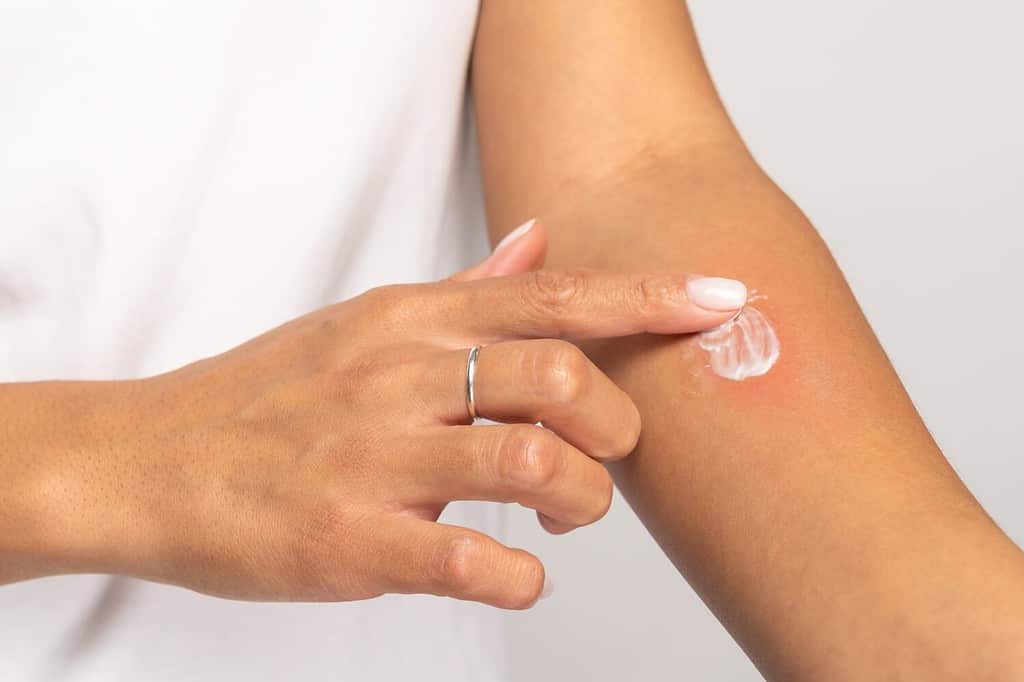
Only female mosquitoes bite humans when they’re getting ready to produce eggs to lay.
©DimaBerlin/Shutterstock.com
Alabama’s climate and landscape make it the perfect home for mosquitoes. Not just one species, either. Across the state of Alabama, you can find 60 different species of insects ready to bite you. The most common you’ll see buzzing around, looking for a tasty arm to land on, is the Asian tiger mosquito.
While it’s difficult to tell just from looking at the flying insect, you’ll want to keep an eye out for the southern house mosquito and the Japanese encephalitis mosquito. These both remain pretty common in Alabama and carry harmful diseases.
Mosquitoes need to bite humans (and animals) to obtain a blood meal. Did you know that only female mosquitoes bite, though? They need that blood meal to produce eggs. Wearing long sleeves won’t help you either; mosquitoes can pierce through materials like cotton, spandex, and denim to obtain their food from your blood vessels.
Chiggers

Chiggers bite at the lines on your body where clothes and skin meet, like bra straps and underwear lines.
©iStock.com/dna_beeb
Long thought of as the bane of fun days on the water and at the lake in Alabama, chiggers are annoying little mites that thrive in warm temperatures and make their homes near water. The chiggers that bite humans are actually just-hatched larvae that attach themselves to your clothes to feed on your skin tissue, which they need to grow into an adult mite.
The most common places for chiggers to bite are behind your knee, your groin and waist area, or ankles. Women with bathing suits should check their bra lines as well, as chiggers like to feed at areas where your skin and clothes have close contact.
Mostly, these bites itch and not much more. They are so common in Alabama (and across the world) that nearly no one reports them, so the actual number of affected individuals remains unknown.
Cockroaches

Cockroaches are annoying pests that feed on food — and human flesh — if hungry enough.
©iStock.com/Wi6995
Did you know that cockroaches have teeth and are omnivores? Because they eat both plants and meat, they can (and will) bite humans. Cockroaches come in droves in Alabama, with nearly 30 species calling the state home.
Never the picky eater, cockroaches will eat both living and dead human tissue. They’ve been recorded to make meals of fingernails, eyelashes, feet, and hands from humans.
Cockroaches are nocturnal, so if you sleep nearby open food, clean it up and erase traces of it to prevent a cockroach infestation. Most of the time, cockroaches will opt for food rather than live human tissue. However, if an infestation exists and the food source is taken away, cockroaches will choose to feed on live human skin.
Fire Ants

Fire ants’ bites create scabby pustules that itch thanks to their stinger’s venom.
©Arlee.P/Shutterstock.com
Lucky for Alabamians, their state is home to three different species of fire ants. The black imported fire ant resides in northwestern Alabama, the red imported fire ant lives in south, east, and central Alabama, and a black-red hybrid between the ant infests much of the north, west, and central part of the state. These ants, imported by accident to the U.S. in the early 1900s through a port in Mobile, have spread to 12 southern states.
Each of the three types of fire ants has the capacity to bite humans several times in a row — up to eight if you can’t get its mandible off of your skin. The bite is actually a sting; it only clamps onto your skin with its mandible so it can inject its venom into you through a stinger.
Fleas
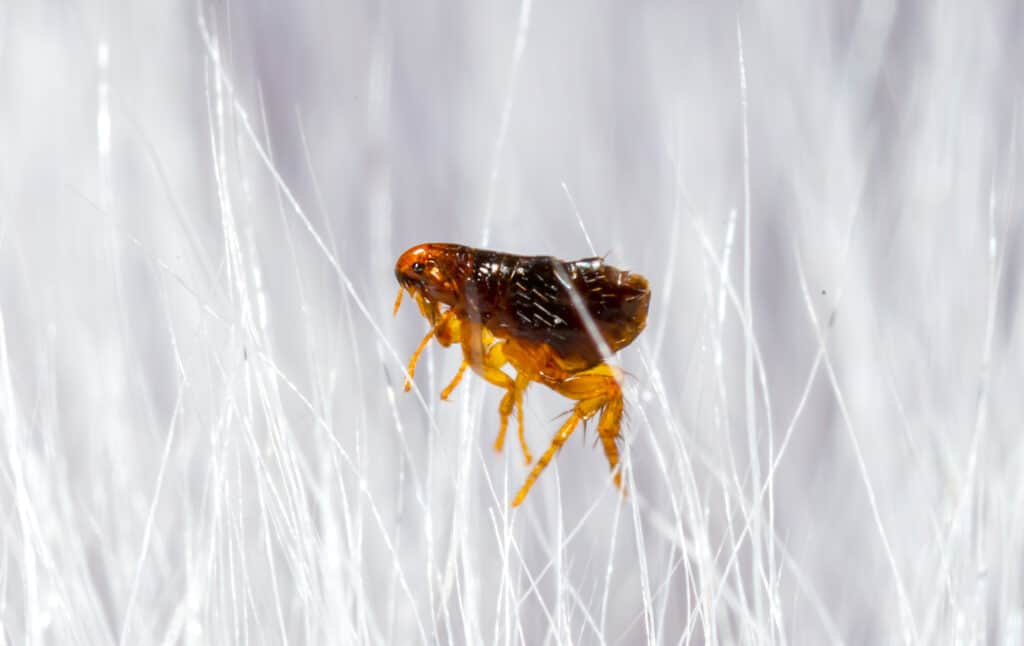
Dogs can pick up fleas easily while outside and start an infestation in your home.
©Vera Larina/Shutterstock.com
Because of Alabama’s warm temperatures, the flea season extends here longer than in other states. Fleas mostly attach to dogs and cats, but will bite and affect humans if they’re hungry and another host doesn’t exist. While fleas can last up to 100 days without a host, they prefer to eat every 12 hours and can consume nearly 15 times their weight in blood.
Identifying if a flea versus another insect is biting you is pretty simple: a flea bite will happen almost exclusively on your lower extremities and be in a straight line (or a cluster). Depending on the type of flea, how long ago you were bitten, and by how many, a small bump will form under the bite. It may even have a thin halo around it.
Most of the time, pets will unknowingly bring fleas into a home — and after a few days, it’s difficult to rid your space of an infestation.
Spiders
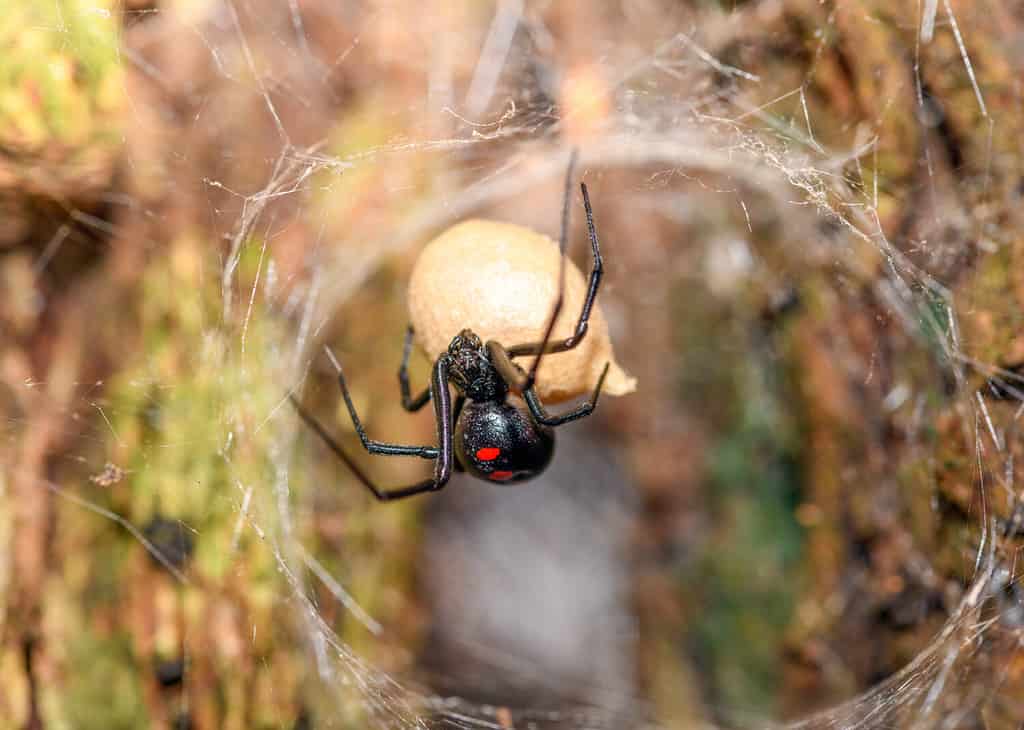
The black widow is one of Alabama’s half-dozen biting spiders.
©Jeff W. Jarrett/Shutterstock.com
Spiders abound in Alabama; many of which look to bite humans if they encroach on their home or territory. The most common biting spiders in Alabama include:
- The black widow (Latrodectus mactans).
- The northern black widow (Latrodectus variolus).
- The brown recluse (Loxosceles reclusa).
- The Chilean recluse (Loxosceles laeta).
- The Mediterranean recluse (Loxosceles rufescens).
- The hobo spider (Eratigena agrestis).
- The golden silk orb-weaver spider.
Spiders in the recluse family tend to like quiet areas of your home or the outside. You can find them in garages, barns, piles of debris, and basements.
If you’re unaware of these biting, venomous spiders around you but get bitten, it might be hard to tell the bite apart from another bug. These bites get inflamed and itch, and may or may not produce a bump. You will be able to identify a bite from a recluse over a widow, as recluse spiders inject necrotizing venom that creates a lesion on the skin. If you get muscle cramps, a fever, chills, soreness, or any other heightened symptom, it’s important to seek medical attention. At that point, you may want to look around your home or think about where you were adventuring to identify the type of spider that bit you — if only to ensure a bite doesn’t happen twice.
Ticks
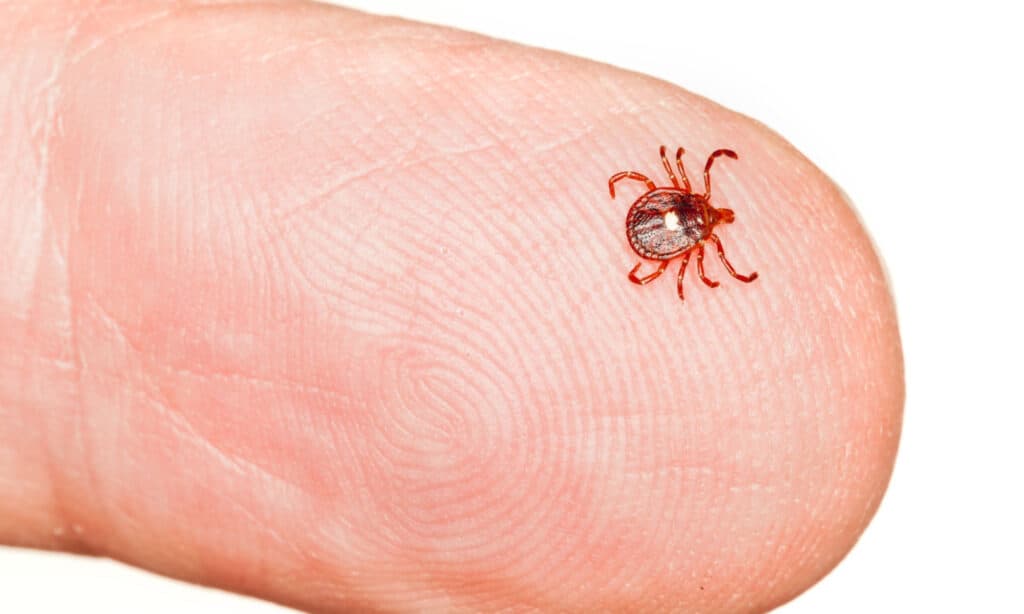
The tiny Lone Star tick can give its host an severe allergy to red meat.
©Steve Heap/Shutterstock.com
Found year-round in Alabama, ticks jump (literally) at the chance to bite humans. Alabama has several different types of ticks in its woods and grassy areas, including the American dog tick, the deer tick, the brown dog tick, the Lone Star tick, and the Rocky Mountain wood tick.
Tick bites affect people differently — some don’t even know they’ve been bitten by a tick unless they see it still attached to their skin. Others experience allergic reactions like sores, redness, swelling, and inflammation, or trouble breathing.
The main concern with tick bites in Alabama is contracting Lyme disease or alpha-gal syndrome. The former causes flu-like symptoms and fatigue while the latter can develop a person’s allergy to red meat after the bite.
Kissing Bugs
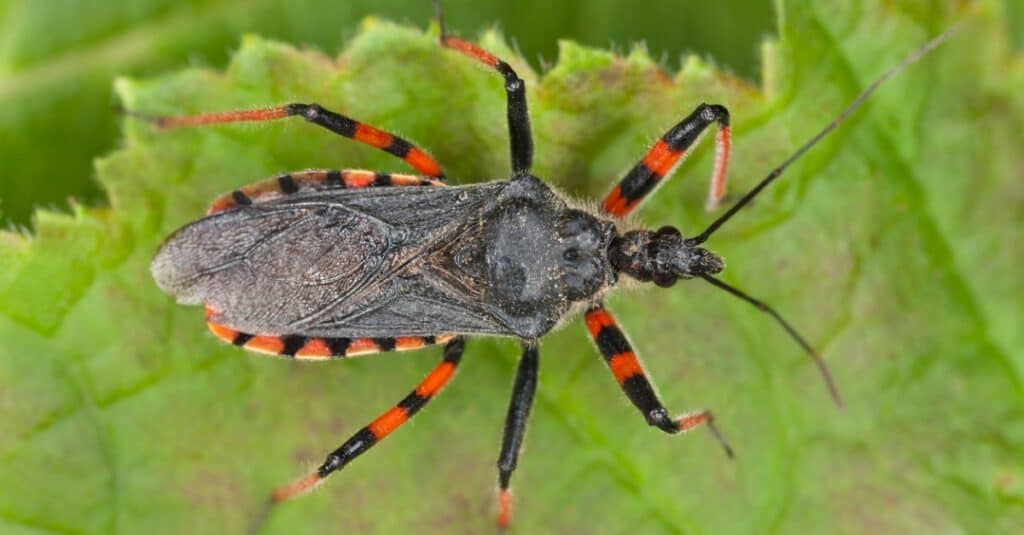
Kissing bugs are most active at night and take a blood meal from hosts.
©Henrik Larsson/Shutterstock.com
Similar to ticks are kissing bugs — which feed on blood. Like cockroaches, kissing bugs are nocturnal. Interestingly, they got their name from the old wives’ tale that they only bite around the mouth or lips. In actuality, they will bite humans wherever they can access and gorge themselves on blood.
While they’d normally feed on small animals in their habitats outside, kissing bugs can easily find their way inside Alabama homes by hitching a ride on a pet, a backpack left next to a tree for a little, or on their own.
Bites from kissing bugs may become red and swollen. More than anything, some people who are allergic to bee stings and tick bites may also be allergic to kissing bug saliva.
Sand Flies, Pinyon Gnats, and Biting Midges
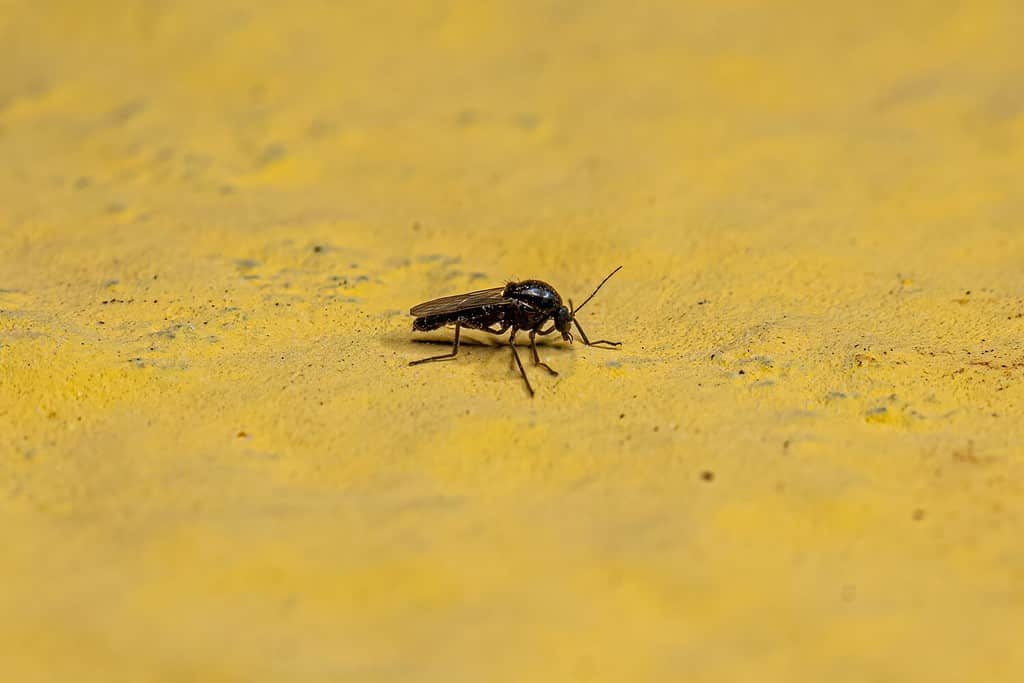
Biting midges, sand flies, and pinyon gnats are one of the most annoying bugs Alabamians spend their summer swatting.
©Vinicius R. Souza/Shutterstock.com
Often called “no-see-ums” by locals, pinyon gnats and biting midges are tiny pests with one of the most annoying bites. They aren’t nocturnal, meaning you won’t have to worry about being their meal while asleep.
Like a mosquito, no-see-ums like to bite humans and suck blood between dawn and dusk. Similarly, only the females tend to bite humans when they’re about to lay eggs to keep their strength up from a blood meal. Thankfully, they are too small to pierce clothing so wearing a long-sleeve shirt or form-fitting clothes will deter most no-see-ums from biting you in Alabama.
Bites usually occur around the warmer months of the year and result in itchy, annoying red bumps.
Beetles
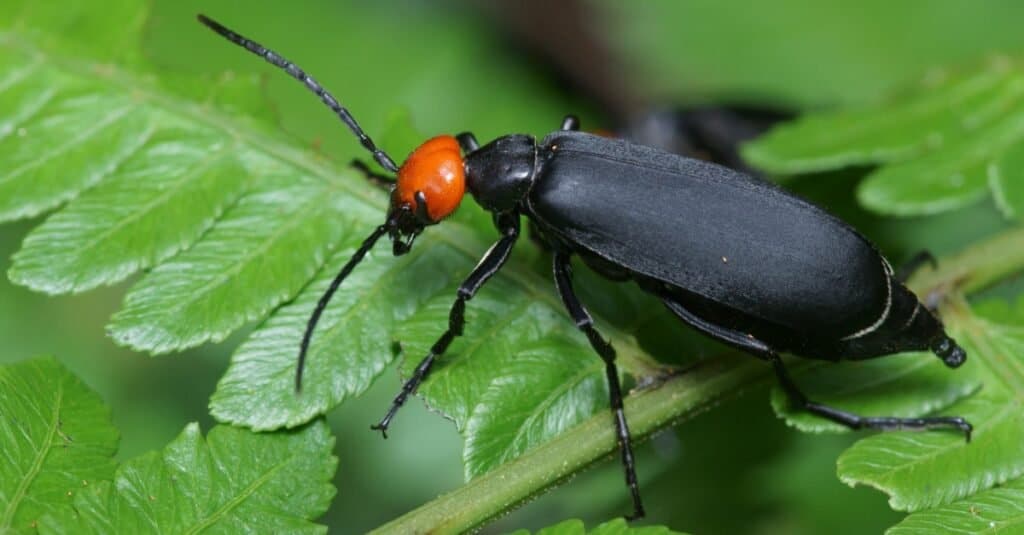
Blister beetles cause painful blisters when a person comes into contact with the caustic substance that they secrete when threatened.
©Suede Chen/Shutterstock.com
Several beetle species exist in Alabama that will bite humans if they feel threatened or are provoked. Mostly, these situations happen because humans unintentionally invade a beetle’s space. When you’re out and about in Alabama, avoid places like rotting wood or animal carcasses, which are two of a beetle’s favorite places to live in the wild. Beetles will make their homes on patios, wooden decks, gardens, and more, though.
Blister beetles and longhorn beetles are two beetle species prevalent in Alabama that bite humans. Bites won’t need medical treatment, but they may create pustules, scabs, or itchy welts for a day or two after the bite.
Keeping the Creepy Crawlies at Bay
While the chances of running into a biting insect in Alabama are pretty high — especially in the summer months — you can keep yourself and your family safe by using insect repellent, being mindful of the places you play and stay outside, and thoroughly washing clothes and skin after coming inside from a day outdoors.
Up next, discover the nine ticks in Alabama or read an entire list of the wildlife you might find in the state.
Thank you for reading! Have some feedback for us? Contact the AZ Animals editorial team.








